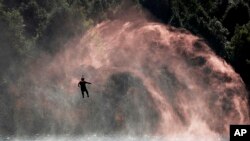Chinese and U.S. commanders on Friday stressed the importance of maintaining military-to-military exchanges under the administration of President-elect Donald Trump, saying they are crucial for building confidence between the two armed forces that remain deeply wary of each other.
Troops from the two sides staged joint drills in the southwestern Chinese city of Kunming on Friday in an effort to better coordinate responses to humanitarian disasters.
"This kind of exchange acts as a bridge to promote relations between the two militaries and I am sure it will be conducted in an even higher level in the future," said Gen. Liu Xiaowu, commander of ground forces for China's Southern Theater Command.
U.S. Army Pacific Commander Gen. Robert Brown also said he would advise the incoming administration to maintain the momentum of engagement.
"These types of military-to-military exchanges are really critical because of the trust they build," Brown said.
Trump has yet to articulate a clear defense policy toward China and the region as a whole, unsettling officials in close U.S. allies such as Japan and South Korea.
Held since 2005, the U.S.-China Disaster Management Exchange is part of efforts to build trust and coordination at a time when the two governments are frequently at odds over disputes in the South China Sea and elsewhere.
The weeklong drills include academic exchanges, a command post exercise and a live troop exercise in simulated disaster conditions. They featured the use of sniffer dogs to find victims in debris, a water rescue and building a pontoon bridge and refugee shelter.
"It has been a very successful exchange of ideas between our two militaries and it will definitely benefit us in organization in the future," said U.S. Army Capt. Jeremy Reynolds.
Deng Yuguang of the Chinese army said the drill offered new perspectives for Chinese troops who have shown greater capacity in dealing with disasters within China, but lack the overseas experience of their U.S. counterparts.
"We have similar exercises by ourselves, but this joint drill is very impressive because the drill helps a lot in improving our disaster rescue and relief capability," Deng said.
Along with the Kunming drills, the Chinese and U.S. militaries have joined in naval exercises off the coast of Hawaii and other limited multinational drills mainly aimed at dealing with humanitarian disasters. They've also tried to improve mutual trust through agreements on dealing with unexpected encounters at sea.
Despite those, China deeply resents the presence of the American Navy in the South China Sea, which Beijing claims virtually in its entirety, while the U.S. has been moving to strengthen alliances with friends and partners throughout Asia.







